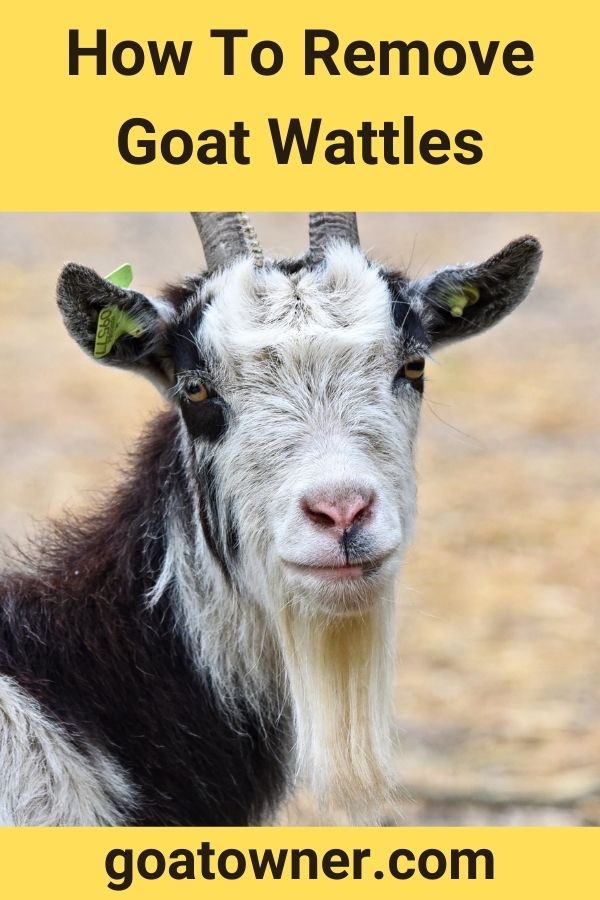I went to goat show the other day with a few of my friends who also raise goats.
We were admiring the many beautiful animals when one of them commented on the fact that none of the competition goats had wattles.
In our herds at home, about half of the goats had wattles, and we knew wattles were pretty common.
I explained that the goats at the competition had their wattles removed, because wattles are not seen as favorable in competitions.
So, my friend asked:
How can you remove goat wattles?
Goat wattles can be removed one of two ways. The first involves tying off the wattles, which will cause them to fall off in a few days. The second way entails cutting them off. Both procedures should be done to newborn kids.
Continue reading for more specific details about these two methods, as well as the pros and cons of leaving your goat’s wattles on.
What are wattles and why do goats have them?
Wattles are fleshy appendages (almost like little fingers) that are covered in hair and hang from the area around a goat’s throat or ears.
Wattles are genetically inherited, and can appear in ones, twos, or multiples.
Some owners lovingly refer to them as their goat’s “jewelry.”
They are also called “bells” or “skin tags.”
Wattles can grow on any species of dairy goat, including both cross-breeds and pure-breeds.
There are also accounts of them growing on bucks, though this is rarer.
These appendages serve no purpose; they are what is referred to as a “vestigial” appendage.
This means that at some point in goat’s evolutionary history, they may have served a purpose.
But they no longer do so.
However, it is important to note that wattles are not harmful or maladaptive either.
Still, wattles may be an indicator of a good thing.
According to a 1980 Report on the Relationship Between Body Conformation and Production in Dairy Goats by C. Gall, published in the Journal of Dairy Science, Vol. 63 No. 10 1768-1781 by the American Dairy Science Association®, wattles on a dairy goat are often associated with positive milk production.
Anecdotally, not all farmers agree with this report.
Many assert that their does without wattles produce just as much milk as their does with wattles.
How do you tie goat wattles off?
One way to remove wattles is by tying them off a kid at birth.
Some goat owners tie the wattles off with dental floss, while others use rubber bands.
Several people have reported that the dental floss comes off, but they found greater success with rubber bands.
Within a few days of tying off, the wattles will naturally fall off.
How do you cut goat wattles off?
Another way to remove wattles is to cut them off a kid at birth.
One farmer explains the following method.
First, shave the neck area around the wattle.
Then make an incision at the top of the wattle and proceed to cut downwards to the bottom.
Cut off the wattle and cauterize it, then suture the skin together using two stitches.
Afterwards, apply Fura-Zone wound healing spray.
Another farmer uses a slightly different method.
They suggest pulling down on the wattle slightly to feel for the “knot” at the end of the wattle.
Then, snip just below the knot.
No cauterizing or suturing is necessary with this approach.
Though they do say it’s important to apply a little wound-healing balm like Cut Heal or Fura-Zone.
It should be noted that as long as you remove wattles before the kid is two days old, then there is very little bleeding.
It is much more difficult to remove wattles from an older kid, because the wattle develops three little veins, which will gush blood when the incision is made.
You can reduce the bleeding by crimping the veins.
But, it’s better to just remove the wattles early if you’re choosing to do so.
What are the benefits of removing goat wattles?
Removing wattles will allow your goat to perform well in competitions if you plan to show them.
Having wattles is considered a flaw in competitions.
Outside of competitions, some people have reported their goat’s wattles getting caught and torn as they get older.
This is very uncommon; however, some people still see it as a reason to have the wattles removed.
What are the cons of removing goat wattles?
Every so often when a wattle is removed, a lump can grow at the base of the attachment, which is called a “wattle cyst.”
Sometimes, these cysts fill with fluid and can look like a CL abscess.
They are not contagious, so they will not spread to other goats in the herd.
They are, in fact, benign, but they can be unsightly and possibly uncomfortable for the goat.
What are the benefits of leaving goat wattles on?
Many people find goat wattles adorable.
They choose to leave them on for aesthetic reasons.
Other people choose to leave goat wattles on because they do not want to cause any pain for the newborn kids.
Why remove something that has no negative health repercussions?
What are the cons of leaving goat wattles on?
It is not common; however, some people have reported accidents where their goat’s wattles accidentally get ripped off, which can be very painful for the goat.
Yet, it should be stressed that this does not happen frequently at all, and many people do not see it as justification for removing wattles preventatively.


As goat wattles are hollow vestigial organs, it might make good sense to either remove them or not remove them, according to one’s desires. If removed, one could likely fill the hollow cavity with cream cheese and the wrap them in bacon, and pan fry them for three or four minutes before consuming them.